Propagating plumerias is a great way to expand your collection, or share your favorites with friends.
In this post, I’ll talk about the different methods, tell you when and how to take cuttings, and then show you how to root them, step-by-step.
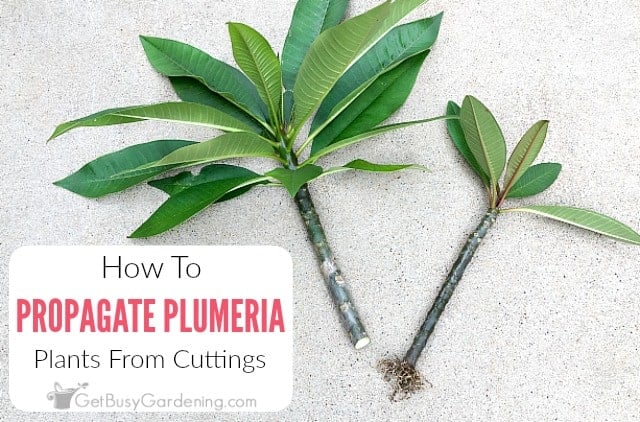
Though it sounds like it would be difficult, plumerias (aka: frangipanim, kalachuchi, or Hawaiian lei tree) are surprisingly quick and easy to propagate.
Below I’ll talk about the different methods you can try, and then dive into all of the information you need to know, including my best tips for success.
It’s fun and addicting once you learn how, and I’ll walk you through the exact steps in this detailed guide for propagating plumerias.
Can You Propagate Plumeria?
Over the years a lot of people have asked me “can I grow plumeria from a cutting?“. Well, I’m sure you know by now that the answer to that question is YES!
Since I’ve been asked that so many times, and I have several years of experience doing it myself, I finally decided to write a step by step tutorial on how you can do it too.
Plumeria Propagation Methods
There are two main ways to propagate plumerias: from seed or by rooting the cuttings.
In this article, I will show you how to grow plumeria from cuttings. I’ll save the seed starting for a future post.
I know it sounds scary, but it is actually pretty easy. First, let’s talk about when is the best time to try it.
When To Take Plumeria Cuttings To Propagate
The best time of the year to take plumeria cuttings for propagation is in the warm spring and summer months, especially when it’s humid outside.
If you take them too late in the summer, or in the fall as the mother plant is starting to go dormant for the winter, then they probably won’t root, or it will be much slower.
Rooting Plumeria Cuttings In Winter
Plumerias go dormant during the winter, so if you take the cuttings too late, they will likely won’t root. However, if you store them correctly, you can overwinter them until spring.
Just wrap the cutting with paper, or leave it in the pot and keep the soil completely dry. You can mist it every once in a while if you want, but don’t overdo it or it could end up rotting.
Then in early spring, give it a good, deep drink, and follow the step by step instructions below for rooting it.
How To Cut Plumeria For Rooting
There are a few things you’ll want to keep in mind when cutting plumeria stems and branches for rooting.
It doesn’t make a difference where you cut it, so it’s just a matter of how big or small you want it to be. You can root any size cutting, but you’ll have the best chance if it’s at least 3-4″ long.
But you do want to be sure to use a sharp pair of pruners, and always sterilize them so you get a nice clean cut.
Also, plumerias are very prone to tip rot, so it’s extremely important to always make your cuts at a downward angle so that water can’t settle into the wound.
How To Grow Plumeria From Cuttings
Before you get too excited and stick your plumeria cutting directly into the dirt, there are a few steps you’ll need to take to prepare it for the best chance of success.
First, remove the leaves from the cutting. This will allow it to put all of its energy into producing new roots, rather than maintaining the foliage.
Second, be sure to allow the wound to cure (dry out) before you attempt to root it. This step is super important, so don’t skip it, otherwise your plumeria cutting will likely rot instead of forming roots.
To do that, simply let it sit in a dry place until the wound is completely callused over. This can take several days to over a week, so be patient, and don’t rush it.
Related Post: How To Grow Plumeria In A Pot
Rooting Plumeria Cuttings In Water
Another common question I get asked is “can I root my plumeria in water?“. The short answer is yes, technically it is possible.
However, rooting frangipani cuttings in water isn’t always a huge success. Many times, the stems will only rot.
If you have plenty of extras to work with, then by all means experiment with this method. It’s always fun to try something new.
My preferred plumeria propagation method however is rooting them in soil. So, I’ll stick to that for now.
Planting Plumeria Cuttings In Soil
The best soil for rooting plumeria cuttings (also called “medium”) is one that is very quick-draining and doesn’t hold much moisture.
I make my own by combining equal parts of perlite, potting soil, and coarse sand, but you can use a commercial mix instead.
When planting a plumeria cutting in soil, it’s very important that you always use a clean pot to avoid any type of contamination.
Also, make sure you don’t use a huge container for rooting each cutting, otherwise you risk overwatering, which will only cause it to rot.
I use 4″ pots for rooting most of mine, and once in a while I might go up to a 6″ one for larger stems or branches.
Related Post: How To Choose The Best Plumeria Soil
Plumeria Cutting Care While Propagating
For the best chance of rooting, keep the air around your plumeria cutting humid, but the soil on the dry side.
If you live in a humid climate like I do, you don’t need to do anything special. Simply leave it outside, and soon it will root. Just be sure to keep it out of the full sun until then.
But, if you live somewhere dry, or you’re trying to root one indoors, then it’s a good idea to mist it every couple of days with a plant sprayer.
Just don’t water the soil, you want that to stay on the dry side. If it’s too damp, it will only cause your plumeria cutting to rot, and you don’t want that.
You’ll know your cutting has successfully rooted once you see new leaves forming the top.
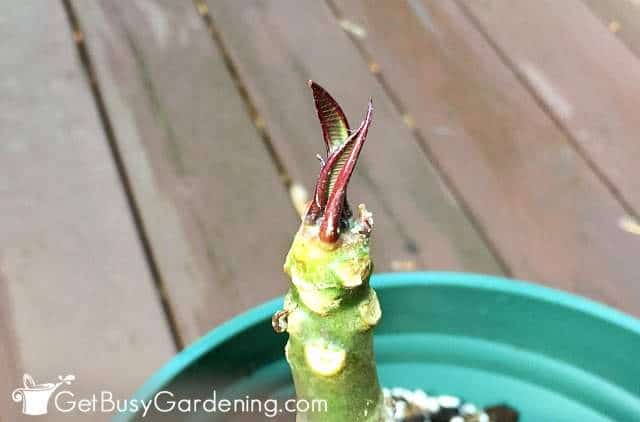
How Long Does It Take Plumeria Cuttings To Root?
How long it takes for plumeria cuttings to root depends on the environment. But in the right conditions, the roots will start forming in as little as 2-3 weeks.
However, if it’s really dry, wet, or too cold, then it will take much longer. For the fastest results, keep them in a bright, warm, and humid location out of the direct sun.
Why Is My Plumeria Not Rooting?
Your plumeria may not be rooting due to over or under watering, lack of light, or the temperature is too cool.
The soil needs to be kept on the dry side at all times, and it should never be wet. A moisture meter can help you maintain the perfect balance
Also, the roots will form best when it’s between 75-85°F. You can use a heat mat placed under the pots to speed things up.

Transplanting Plumeria Cuttings After Propagation
Once your plumeria cutting has several mature leaves, then you know it’s propagated and ready to move into a new pot or the ground.
You certainly don’t need to worry about transplanting your kalachuchi cutting right away, you can leave it in the small container until it becomes pot-bound if you’d rather.
The best potting soil to use is a porous fast-draining mix, and you should always plant them a container that has drainage holes.
Or you can try to make your own by mixing coarse sand and perlite or pumice with general potting soil.
Once your new baby has become established, you can start fertilizing it to encourage flowers, the cuttings can bloom their first year.
Related Post: How To Care For Plumeria Plants (Hawaiian Frangipani)
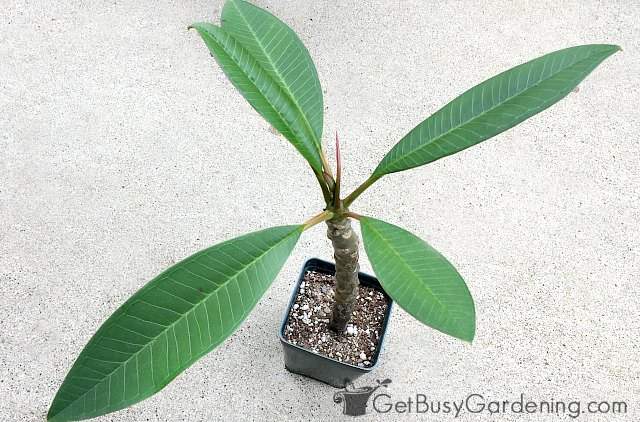
Plumeria Propagation FAQs
Below I’ll give you answers to the most frequently asked questions about rooting plumerias. If you can’t find what you’re looking for here, add a comment below.
Can You Replant A Broken Plumeria Branch?
Yes, with some care, you can replant a broken plumeria branch. Make sure the branch is dry and not rotten. If the broken end is mangled or crushed, then cut off the damaged parts so you have a clean edge. Clip off the leaves, and leave it to dry in a shady place for a few days. Then follow the steps below to root it.
How fast do plumeria cuttings grow?
Plumeria cuttings can grow very fast in the right conditions. It can take as little as 2-3 weeks for the roots to start forming.
How long do plumeria cuttings last?
Plumeria cuttings can last several months without being planting. However, they will slowly start to shrivel over time, so the sooner you root them after they’re properly callused, the better your success rate will be.
Can frangipani be propagated in water?
Yes, frangipani can be propagated in water. However, it’s not the best method to use, as the cuttings can easily rot. It’s a fun experiment to try if you have extras, but for the greatest chance of success, I recommend rooting them in soil.
Can you plant a fresh plumeria cutting?
While you can plant a fresh plumeria cutting, I highly recommend you let dry and fully callus over first. If you try planting it with a fresh cut, it has a much higher chance of rotting rather than rooting.
Plumeria propagation by cuttings sounds like it would be really hard, but it’s actually pretty easy when you follow these steps. It’s really fast too, so once you get the hang of it, you’ll have plenty of new starts to share with friends!
If you want to learn how to multiply any type of plant you can get your hands on, then my Propagation Made Easy eBook is for you! It has everything you need to know in order to start propagating your favorites right away. Download your copy today!
More Plant Propagation Posts
- The Best Plant Propagation Tools, Equipment & Supplies
- Plant Propagation: A Detailed Guide For Beginners
- How To Propagate Aloe Vera By Division
- Propagating Christmas Cactus From Cuttings Or By Division
- How To Propagate Banana Plants
- How To Propagate Snake Plant (Sansevieria) In Water Or Soil
Share your plumeria propagation tips in the comments section below.
Step By Step Instructions
How To Propagate Plumeria Cuttings

Rooting plumeria cuttings is easy once you know the right way to do it. Follow these detailed step by step instructions for the best results.
Instructions
- Take and cure the cutting - Use a clean pair of sharp pruners to take 3" or longer plumeria stem or branch cuttings. Then place them in a dry location out of direct sunlight for at least a week, or until the wound has callused over.
- Prepare the rooting medium - Use a commercial fast-draining medium, or try mixing equal parts of regular potting soil with perlite and coarse sand. If it's bone dry, dampen it slightly. Then use your trowel to fill the pot.
- Apply rooting hormone - Dust the callused end of your plumeria cutting with rooting hormone. This will help it produce strong, healthy roots, and also make the process faster.

- Plant the cutting - Make a hole in the medium that’s deep enough so the cutting will stand up on its own. Put the cut end into the hole, and gently pack the soil down around the base. The roots will sprout out of the bottom of the stem, so you don't have to plant it very deep.

- Place somewhere warm and bright - Put your cutting in a humid location with bright light. Placing it on top of a heat mat can speed things up, but it’s optional. Once you see new leaves on top, that means your frangipani cutting has rooted. You can pot it up into fresh soil if you want, but only go one size larger than the current container.
Notes
- The larger your cutting is, the longer it should cure. You'll know it's ready when the cut feels dry and hard. Do not skip this step or it may end up rotting.
- While your plumeria cutting is rooting, keep the medium on the dry side. If it’s too wet, the cutting will likely rot. You can use a moisture gauge to monitor it.
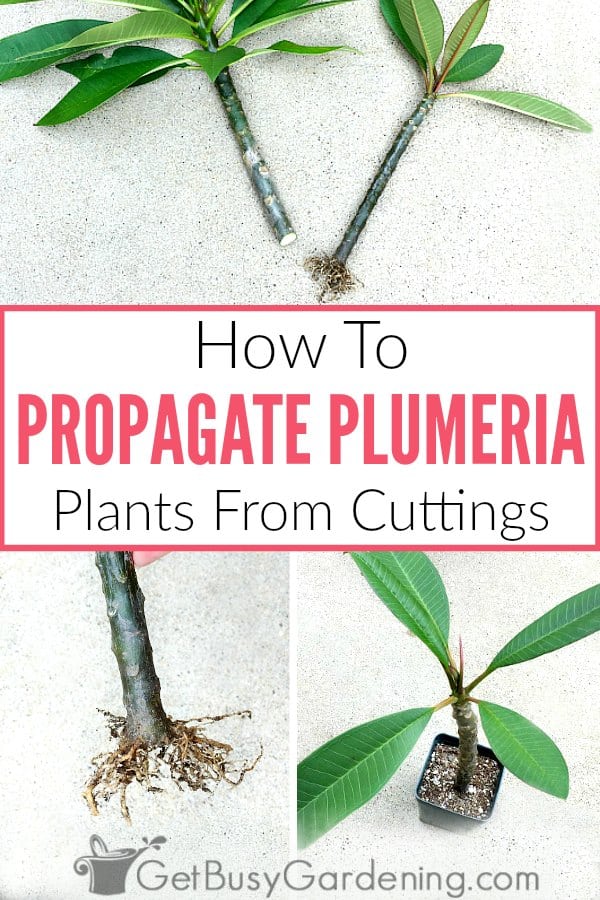
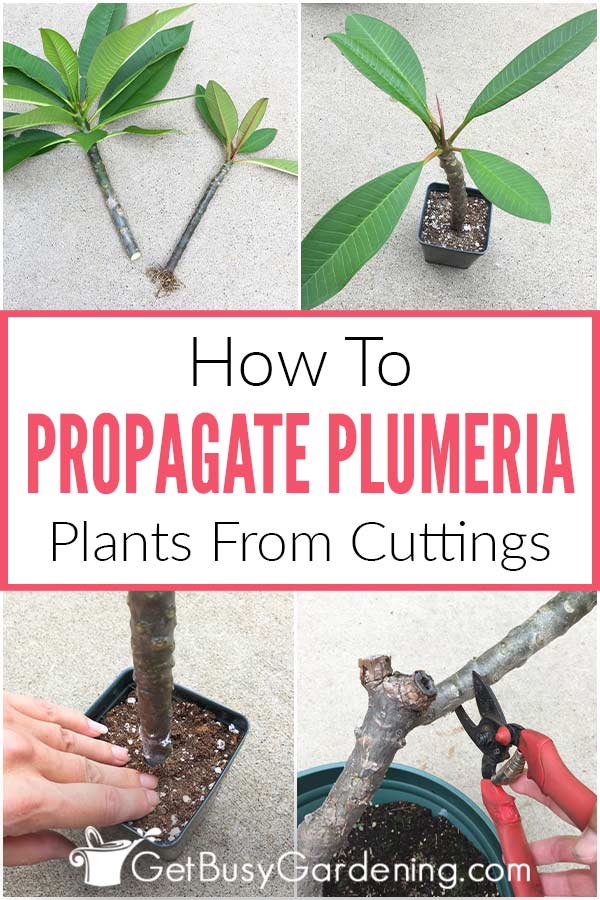
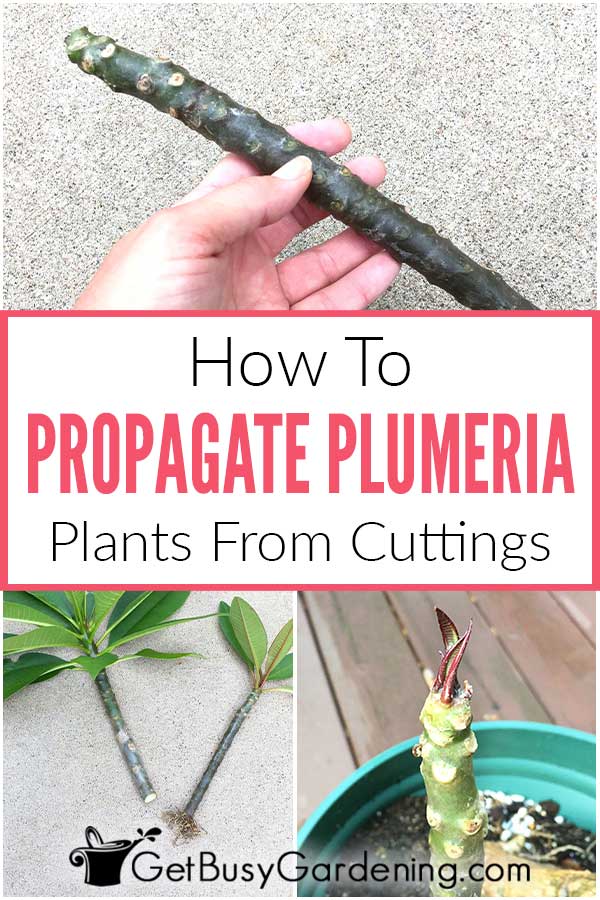

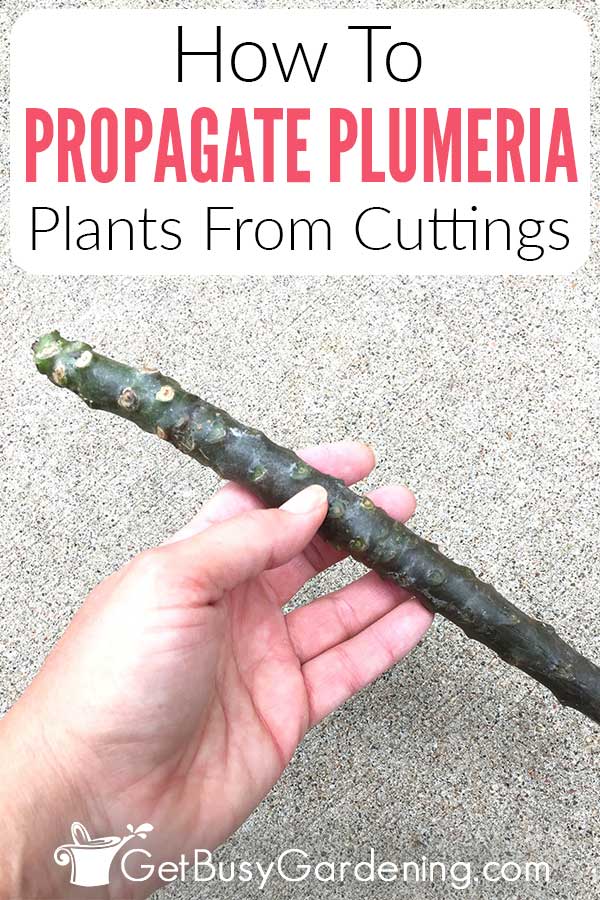

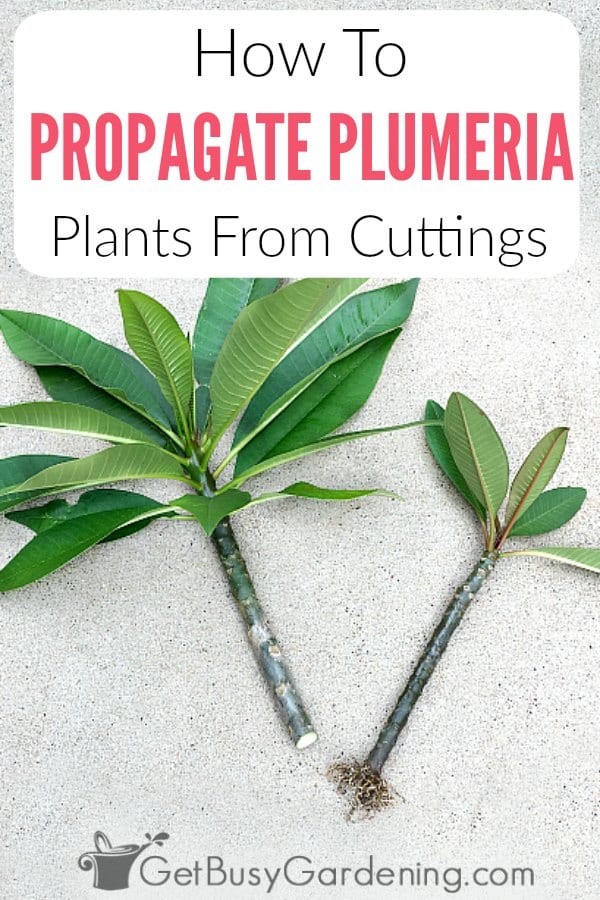

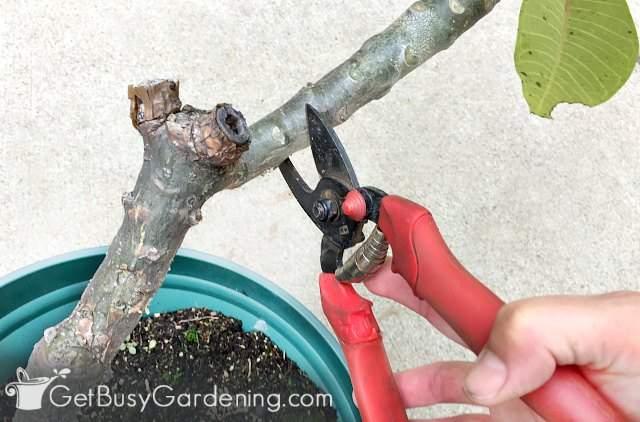
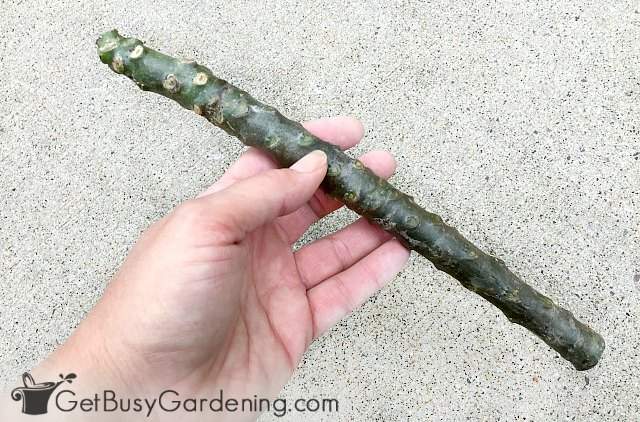


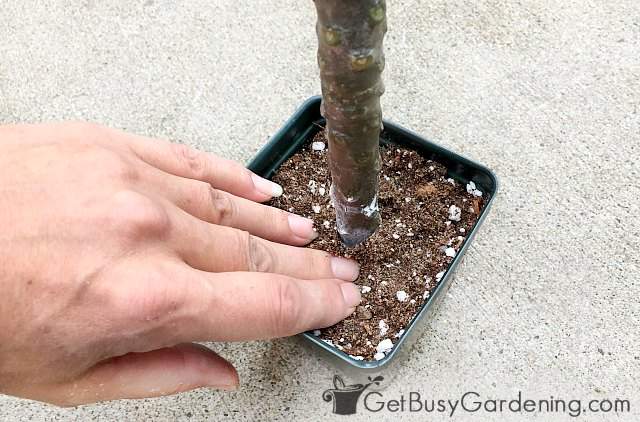

Kristine Milliken says
Hi! We just had a wind storm and my large plumeria snapped. On this page it said if that happened to trim the leaves, but my plumeria has hundreds of leaves and was blooming when it broke. How can I keep this from dying? I can send a picture if that helps. Thank you so much!
Amy Andrychowicz says
Oh no, I’m so sorry to hear your plumeria tree snapped! If it’s a large tree and the entire thing snapped off at the base, then I personally would take some smaller cuttings from the branches and get those rooting first, following the steps in my tutorial. Then I would dig a hole deep enough to hold the trunk of the tree, plant the whole thing (and stake it up) to see if it will take root (hopefully it’s not too heavy to move). I’ve never tried this with an entire plumeria tree, so I cannot speak from experience, but it’s worth a try. I don’t think it’s worth removing all of the leaves and flowers from the large tree, that sounds like a lot of work. But I would recommend doing that for your branch cuttings. Good luck!
Jan Albright says
I have been growing a cutting for a couple of years now. It grows leaves and looks great and then out of nowhere the leaves fall off. Then it grows new leaves. I fertilize about once a month. Any suggestions? Also, it has never bloomed. Thanks in advance!! – Jan
Amy Andrychowicz says
Many types of plumerias naturally lose their leaves in the fall as they go dormant for winter, so it might just be the normal lifecycle. Here are a few posts to help give you more details about how to care for your plant (and get it to bloom) and also help it through the natural dormancy period.
How To Care For Plumeria Plants
How To Overwinter Plumeria Plants Indoors
Michael L Merrill says
Hi Amy,
I had a tree branch land on my two plumeria plants and broke the main stem and shattered them. One main stem is about 5 ft tall. About 3 ft up on the main trunk, the bark was completely torn off actually looking like it got ringed. There’s no bark all the way around the Woody stem. Does the upper part need to be repropagated or will it continue with the water transfer coming up from the inside? Thank you, Mike
Amy Andrychowicz says
If only the bark was stripped off and the rest of the main stem is in good shape, then I think your plant would be fine. However, you said the main stems on your plumerias were shattered, so if they are completely crushed, then it’s best to take cuttings of the firm, healthy branches and root them. Otherwise it’s likely the crushed stems will rot and the whole plant will eventually die.
Debbie says
Hi Amy, Thank you for the informative article. I bought three stems and planted them. One is spouting small leaves, one is still a stick, and the problem child now has withered tips. I’m waiting on the stick, celebrating leaves and planning to cut off the withered tips. If I pulled it out of the dirt and let the newly clipped places dry out, will it be ok? Do I need to do anything to the bottom? Recut it? Need some direction. Thank you.
Amy Andrychowicz says
It’s great to hear that you’ve had success rooting at least one of your plumeria cuttings, congratulations. For the one that’s withering, check the base and entire length of the stem for signs of rot. If the stem is still fairly firm and there’s no rot, then yes, you could pull it out of the soil to check the end for rot too. If all looks good, then it might just need a bit of moisture and more heat/light. In that case, I wouldn’t try recutting it, but you could dust more rooting hormone on the cut end. They will root best with plenty of warmth and light, and a slightly moist soil in the summer (never wet, but also not completely bone dry). Good luck!
Penney E Hanson says
Our Plumeria branch has successfully sprouted large leaves after being potted 6 weeks ago. We are in southwest Florida and it has loved the weather and staying out of the sun and rain on the lanai. At what point can we put it in the sun?
Amy Andrychowicz says
Now that it’s getting new leaves, it means your plumeria cutting has roots. Congrats on your success! You can slowly acclimate it back to the full sun over the period of a week or two. The leaves can burn when they aren’t used to direct sunlight, so monitor it and give it time to slowly get used to the full sun again.
Hannah says
Hi! I just planted four plumeria cuttings in small pots last week. I waited until they callused, used a rooting hormone, and then followed your directions on the soil and the sun. I live in Palm Beach, FL. so the conditions are perfect here! Only problem is, last night there was a pop-up rainstorm and they got drenched! So I’m wondering what you suggest I do next? Thank you so much!!
Amy Andrychowicz says
As long as they are in pots with drainage holes, your plumeria cuttings should be ok. I would just put them in a spot where they’ll be protected from future rain so you can control how much water they get, and make sure the soil dries out before watering them again.
Jackie Williams says
My husband just weed whacked my Plumeria – should l remove the leaves for it to root or can l just put it back in the ground?
It was a beautiful full plant.
Thanking you in advance for your much appreciated help.
Jackie Williams
Amy Andrychowicz says
For the best results, definitely follow the steps I outlined in the article. It’s best to remove the leaves from your plumeria cuttings so that they will focus all of their energy on growing roots rather than supporting the leaves.
CS says
I am experienced rooting many other cutting types and always scraped the sides at the bottom of the cutting before using rooting hormone. It stimulates more roots and faster, too. I do not see anyone doing this with plumeria cuttings. Does this not work for plumeria? It seems like it would not because of the callusing requirement that most other cutting types do not have.
Amy Andrychowicz says
It’s definitely best to let the wound callous over on plumeria cuttings before trying to root them or they could end up rotting. But if you have several cuttings, it wouldn’t hurt to experiment with it. I’ve personally never tried doing it that way, so I can’t say for sure if it would work.
Steve says
I live up in Canada and I’ve had two cutting in pots for two months and they haven’t rooted. They’ve only shriveled a bit. What am I doing wrong. They are in the sun and I water them every 5days or so. Should I stop watering them and take them out of the direct sun? Please help!
Amy Andrychowicz says
Plumeria cuttings need lots of warmth in order to root, so my guess is that it’s been too cold for them. But they also go naturally dormant during the winter, so it could be that they are still hibernating. Keep them in the sun, but see if you can also add bottom heat or warm up the room they are in. That will help to speed up the rooting process, and wake them from their winter slumber. Good luck!
Crisálida says
Hi, I found this website out of desperation. I live in Champaign, Illinois. I have a beautiful plumeria tree since 2015. It blooms each summer. However last summer 2022 did not bloom outside. I brought the plant inside for the winter and in in February 2023, I saw blooms! This time the blooms changed color, from pink, yellow and white to pure white leaves and yellow in the middle. So beautiful. As I’m taking pictures the beach with the flowers broke. I have successfully got a new plant from seeds. I have bought several cuttings from different growers with no luck. Now, I have the broken branch, I’m sad and I don’t know how to properly save the branch. It has all the flowers and leaves, so pretty. I have put some cinnamon powder to protect the tree. I did the same thing for the branch. Could you be so kind to let me know what to do next? I really want to save this branch. It is about 11 inches tall. Looking forward to your reply, .
Blessings and take care.
Crisalida
Amy Andrychowicz says
Oh no! Sorry to hear you broke off a branch from your plumeria. But congrats on getting it to bloom every year in Illinois! That is very impressive!! The first thing you should do is make sure the broken end has a nice clean cut. If it’s crushed or jagged it may not root as well. So, if necessary, use a sharp, sterile pruners or a knife and make a clean cut on the end. Also, you’ll need to remove all of the leaves and flowers so that the cutting can spend all of its energy on rooting. Then let it cure (dry out) for at least a week or more so that the cut end is completely calloused over and feels dry to the touch. Then follow the step by step instructions at the bottom of this article to root it in soil. Good luck!
Janice Larson says
I have a very tall, leggy plumeria that we forgot outside with the cold so when we brought it in we thought it might die because it froze… all the leaves died and fell off so ive just left it alone because Im afraid to cut it down to a better height but now ive noticed that its starting new growth on the very top that I need to cut down so the plant is smaller….. Help! ( Haha)
Amy Andrychowicz says
Great to hear that your plumeria survived the freezing temps! Definitely wait until spring to prune it, and don’t cut back all of the branches at once. Start with a few and let it recover before taking more.
Joe Nutter says
My parent plant has three branches at the top. If I want to make cuttings out of the three branches, will the parent plant sprout again from the clipped ends? Or should I only clip one branch at a time?
Amy Andrychowicz says
Yes, your plumeria branches will regrow just below where you make the cut. It’s a good idea to just cut one branch at a time, and wait for it to start to put on new growth before taking more cuttings.
Margo Wethal says
Hi Amy Recently I lost my plumeria outdoors due to t he hurricane…a trampoline landed smack dab on top of it . I have removed the leaves and am drying the long stems. I would like to make several cuttings from the long stem but don’t know what to do with the top of the new cutting which would be a fresh cut. I know what to do with the bottom of a fresh cutting but not a top . Please give me an idea ….thanks
Amy Andrychowicz says
Oh no, I’m so sorry to hear your plumeria was destroyed like that, so sad! But the good news is that you can propagate the cuttings from anywhere on the stem. So, if you cut one large piece into several, you can root them all. Just let them cure so the cut callouses over before you try rooting them. Good luck, and enjoy all of your new babies!
K M Meyer says
If I trim my large plumerias in the fall, can I leave the cuttings unplanted over the winter, then root them in the spring?
Amy Andrychowicz says
Yes, I have successfully overwintered plumeria cuttings before with no problems. You can start the rooting process in late winter or very early spring.
LeAnn says
My cutting was starting to grow leaves, but they never grew, then they developed black on them. Do you know what the problem is? The stem is still firm.
Thanks for publishing this article. I have not been able to get plumeria cuttings to propagate until I came across your information. I have one other cutting that’s doing great. My big plumeria is getting old, so I’m going to start taking more cuttings from it and let it go. I’ll have lots of grandbabies! LeAnn
Amy Andrychowicz says
As long as both the stem and tip of your plumeria cutting are firm and healthy, then I wouldn’t worry about the leaves turning black and falling off. I’ve had that happen before with the first few baby leaves on mine, and after a few weeks, the new ones came in fine. It could just be that it hasn’t formed roots yet, and it’s dropping the baby leaves so it can focus on root formation. But it could also happen when they’re overwatered, so check the soil moisture level too. It should be kept on the dry side while the cutting it rooting.
LeAnn says
Thanks, Amy! I’ll be patient and see what happens. I’ll make sure I keep the soil dry.
Amy Andrychowicz says
You’re welcome!
Nora says
Hi Amy, thanks so much for your helpful article. I was just given a 2.5 foot long cutting, with leaves, which has already been rooted. I’ve just potted it, with the media level about 3-4 inches above the base/roots. Is that too deep?
There are what appear to be a couple of tap roots about four inches long, and then some shorter lighter roots around those. Will it harm it that I sunk it in a few inches above the roots? I staked it and put it in a heavy pot, but it’s so top heavy, I’m reluctant to have the soil surface lower, just above where the roots start.
Amy Andrychowicz says
That does sound a little too deep to me. You should plant plumerias only deep enough to completely cover the rootball. I’m afraid that planting them 3-4″ deep may end up causing the main stem to rot. I would plant it a little shallower personally, and just stake it so it doesn’t fall over. Once it’s established, it will have no problem standing up on its own.
Nora says
Thanks Amy, I’ve removed the top layer of the potting media to get within about 1/2 inch of the top of the root ball. The main stem seems fine so far but it does look like it was too much media for the amount of roots. Fingers crossed!
Amy Andrychowicz says
You’re welcome! Fingers crossed here too. 🙂